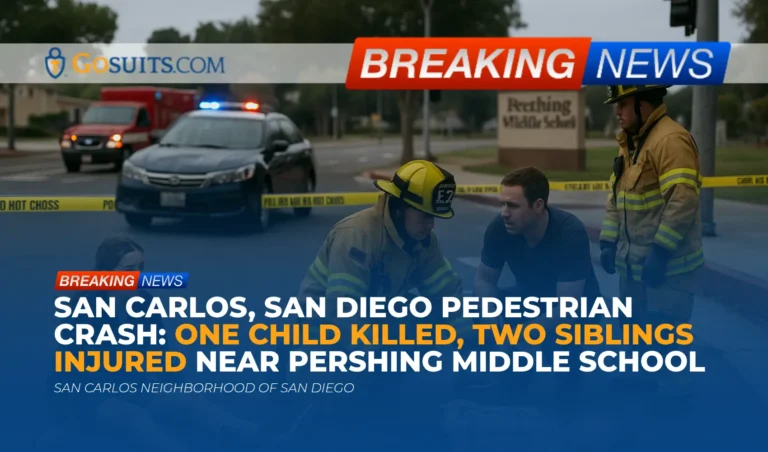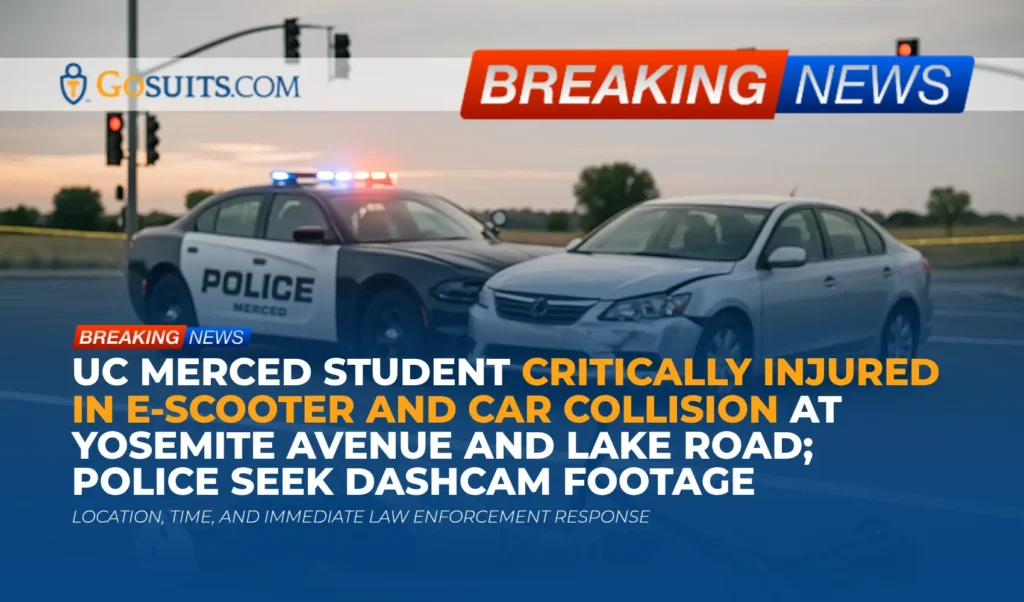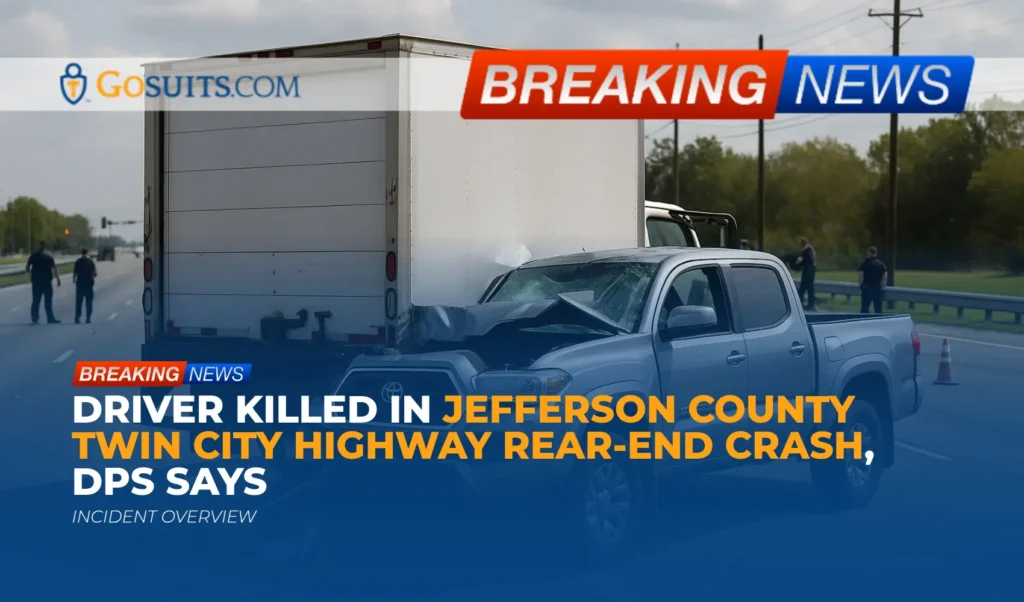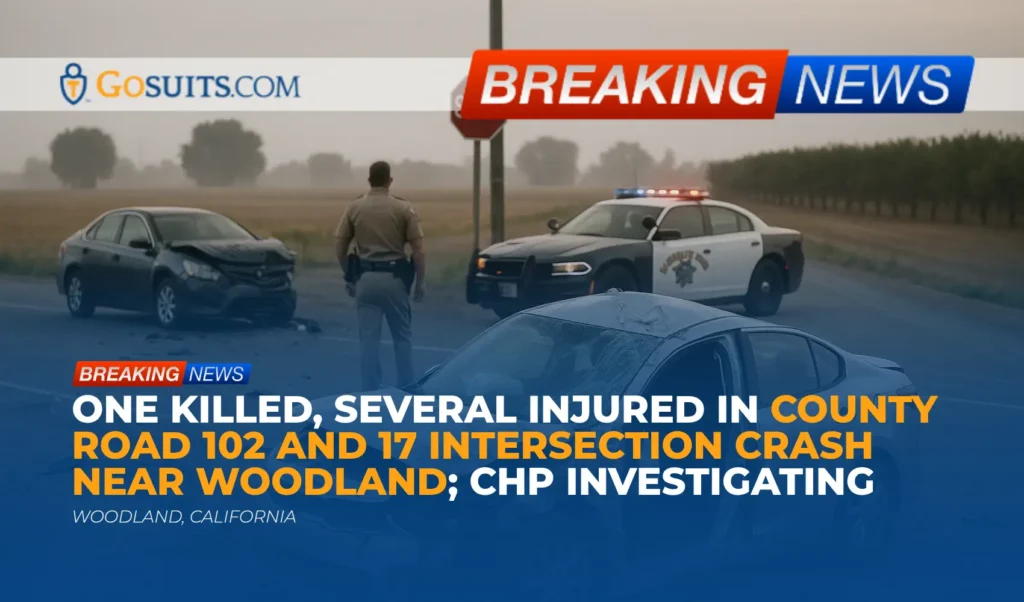- What we know about the San Carlos pedestrian crash
- Immediate steps for families and witnesses
- How to obtain official records and information in San Diego County
- Understanding pedestrian right-of-way and school-zone duties in California
- Possible civil liability and claim pathways after a child pedestrian crash
- Insurance coverage considerations under California law
- Key timelines and legal deadlines in California
- Safety context: child pedestrian injuries and school-hour risks
- Support resources for students and families coping with trauma and loss
- Commentary from Gosuits San Diego, California Personal Injury Attorney
- Why timely action matters now
What we know about the San Carlos pedestrian crash
A tragic collision in the San Carlos neighborhood of San Diego left one child dead and two others critically injured Monday morning. According to statements reported from on-scene law enforcement, the three children — two girls and one boy, all siblings around the age of 12 — were crossing Jackson Drive at Lake Badin Avenue just before 7:30 a.m. on their way to Pershing Middle School when they were struck by a Honda sedan. San Diego Fire-Rescue transported the children to Rady Children’s Hospital. One child was pronounced dead at the hospital; another sustained serious fractures; the third was described as sitting and talking with first responders.
The driver, a man in his 30s, remained at the scene, attempted to provide aid, and was not physically injured. Police at the scene indicated that speed and driving under the influence were not suspected as factors at that time. The roadway was closed for investigation, and authorities asked nearby residents to share any doorbell or surveillance footage that might show what happened. Investigators also notified Pershing Middle School, which began offering counseling resources for students and staff.
As this remains an active and developing investigation, details may change as more information becomes available. Our hearts are with the children, their family, classmates, teachers, and the San Carlos community during an unimaginably difficult time.
Immediate steps for families and witnesses
After a serious pedestrian crash, families are faced with urgent medical, practical, and legal needs all at once. The priorities below focus on care, preservation of information, and avoiding missteps that can affect future civil claims. These are general considerations; every situation is unique.
For families
- Focus on medical care and follow-up. Keep all discharge instructions, imaging results, and referrals. Save copies of every bill and explanation of benefits. These records become crucial for documenting injuries and future care needs.
- Preserve clothing and personal items worn or carried during the crash in a clean paper bag. Do not wash or repair items. They may be important evidence of impact, debris, or visibility.
- Document the recovery journey. Maintain a journal of symptoms, pain levels, missed school, emotional changes, and daily limitations. For children, note changes in sleep, behavior, or concentration that teachers or caregivers observe.
- Identify and save potential evidence such as phone photos, the location of debris, and names of any witnesses who approached you at the scene or later.
- Be cautious with insurance communications. Before speaking with any insurance adjuster, consider consulting a qualified attorney. What is said to an insurer can be recorded and used to limit or deny a later claim.
For neighbors and witnesses
- Share any video promptly. If you have doorbell or security camera footage covering Jackson Drive and Lake Badin Avenue around 7:15–7:45 a.m., contact the San Diego Police Department’s non-emergency line at 619-531-2000 or visit the department’s information page at sandiego.gov/police/services/nonemergency.
- Write down what you saw while it is fresh, including traffic light phases, vehicle movements, visibility conditions, and any pedestrian signals or crossing patterns observed.
How to obtain official records and information in San Diego County
Traffic collision report (San Diego Police Department)
The official collision report is often one of the most important documents for a civil claim. It typically includes diagrams, statements, scene measurements, and any citations or noted violations. In San Diego, reports are maintained by the Police Department’s Records Division.
- Where to request: SDPD Records Division. See the department’s records information page at sandiego.gov/police/services/records for request methods, identification requirements, and fees.
- Who can obtain: Typically involved parties, their legal representatives, and in fatal incidents, next of kin or their representatives. Processing times vary; follow the most current SDPD guidance.
Medical Examiner records (San Diego County)
In fatal incidents, the San Diego County Medical Examiner determines cause and manner of death. Next of kin can request reports such as the autopsy report, investigative narrative, and toxicology.
- Where to request: San Diego County Medical Examiner’s Office. Request instructions and eligibility are provided at sandiegocounty.gov/content/sdc/me/family-and-friends/request-records.html.
- What to expect: Some portions of the file may be limited by law, especially involving minors. The Medical Examiner’s site outlines available documents, fees, and typical timelines.
Public records related to roadway design or traffic controls
When a collision may involve roadway visibility, traffic signal timing, signage, or crosswalk placement, families sometimes pursue public records to understand the environment. California’s Public Records Act provides a framework for requesting records from public agencies.
- California Public Records Act overview: oag.ca.gov/ogc/CPRA.
- City of San Diego records portal: The City provides a centralized portal for requests, accessible from sandiego.gov/public-records.
Victim compensation assistance
California’s Victim Compensation Board may help eligible victims and families with certain expenses such as funeral/burial costs, mental health counseling, and out-of-pocket medical costs not covered by insurance.
- Learn more or apply: California Victim Compensation Board (CalVCB) at victims.ca.gov.
Understanding pedestrian right-of-way and school-zone duties in California
California law requires drivers to exercise due care for pedestrians at all times, and it imposes specific duties when pedestrians are crossing in a crosswalk or at an intersection. School hours demand heightened attention from all road users.
Crosswalk and pedestrian right-of-way
- Drivers must yield to pedestrians in marked crosswalks and in unmarked crosswalks at intersections. California Vehicle Code section 21950 requires drivers to yield the right-of-way to a pedestrian crossing the roadway within any marked crosswalk or within any unmarked crosswalk at an intersection, while also directing pedestrians not to suddenly leave a curb or run into the path of a vehicle that is so close as to constitute an immediate hazard. Statutory text: leginfo.legislature.ca.gov.
- Pedestrians outside crosswalks: Section 21954 addresses duties when crossing outside a crosswalk, requiring pedestrians to yield to vehicles, but it does not relieve drivers of the duty of due care to avoid collisions: leginfo.legislature.ca.gov.
School-zone awareness and speeds
- School-zone speed limits: California sets a 25 mph prima facie speed limit near schools under specified conditions, unless otherwise posted. See Vehicle Code section 22352: leginfo.legislature.ca.gov.
- Driver’s duty of due care: Even when traveling at or below the speed limit, drivers must exercise reasonable care based on conditions (visibility, sun angle, congestion, time of day). Children can be unpredictable near schools, requiring extra caution.
Notably, the presence or absence of a marked crosswalk, the function of pedestrian signals, and the specific movement of both pedestrians and drivers are facts determined through investigation. The above statutes set the framework, but each collision requires careful, evidence-based analysis.
Possible civil liability and claim pathways after a child pedestrian crash
In civil law, liability focuses on whether one or more parties failed to act with reasonable care and whether that failure caused injuries or death. Based on public statements so far, the investigation is ongoing; no final fault determination has been made. Generally, the following avenues may be considered in a school-area pedestrian collision:
Potentially responsible parties
- Driver of the involved vehicle: If evidence shows inattention, failure to yield, inadequate lookout, or other breach of the duty of care, the driver and the driver’s auto liability insurer may be responsible for damages.
- Employer of the driver (only if the driver was on the job and acting within the scope of employment). This depends entirely on verified facts such as the nature of the driver’s trip and employment status.
- Public entity responsible for roadway design, signals, or signage, if a “dangerous condition of public property” is proven to have created a substantial risk of injury and contributed to the crash. California Government Code section 835 provides the legal framework: leginfo.legislature.ca.gov. This requires expert evaluation and usually extensive records review.
Types of civil claims that may arise
- Wrongful death on behalf of eligible family members for the child who passed away. California Code of Civil Procedure section 377.60 identifies eligible claimants (such as parents and certain dependents): leginfo.legislature.ca.gov.
- Personal injury claims on behalf of the surviving children to recover medical expenses, future care needs, and non-economic damages arising from physical pain and emotional harm associated with the injuries.
- Survival action through the decedent’s estate for certain losses sustained by the child before death. The availability and scope of recoverable items are governed by statute and recent amendments; attorneys often evaluate this in tandem with a wrongful death claim.

Evidence that often matters in pedestrian cases
- Traffic collision report and scene data: Measurements, diagrams, signal phasing, and any statements noted by officers.
- Video evidence: Doorbell cameras, businesses’ exterior cameras, transit cameras, and dashcams.
- Vehicle data: Event data recorder information when available, and the vehicle’s damage profile, which can inform impact dynamics.
- Roadway records: Signal timing charts, crosswalk markings history, line-of-sight evaluations, prior complaints or collision history at the location.
- Medical documentation: Establishes the nature, extent, and causation of injuries or death.
Because children are especially vulnerable road users, investigators and civil practitioners typically scrutinize driver behavior and roadway design standards applicable to school routes.
Insurance coverage considerations under California law
Insurance is often the primary source of compensation after a vehicle-pedestrian collision. The specific policies in play depend on the at-fault party, the status of the driver, household coverages, and any public-entity involvement.
Auto liability insurance
- Minimum required limits in California: California Vehicle Code section 16056 sets minimum liability limits that drivers must carry. Current law sets required minimums; see the statute for details: leginfo.legislature.ca.gov. Actual available coverage may be higher than the minimum, depending on the policy.
- Whose policy applies: Typically the driver’s liability policy; if the driver was using another person’s car with permission, that vehicle’s policy may be primary.
Uninsured/underinsured motorist and MedPay
- UM/UIM coverage: California insurers must offer uninsured/underinsured motorist coverage, though it can be declined. UM/UIM can protect injured pedestrians if the at-fault driver lacks sufficient coverage. See California Insurance Code section 11580.2: leginfo.legislature.ca.gov.
- Medical payments coverage (MedPay): Some auto policies include no-fault MedPay that can help with immediate medical bills for household members, including when injured as pedestrians.
Health insurance coordination
Health insurance generally pays medical care upfront, subject to co-pays and deductibles. If a third party is later found liable, the health insurer may seek reimbursement from any settlement based on policy terms and applicable law. Keeping detailed records of out-of-pocket costs is important.
Public entity claims
If a claim involves a public entity (for example, alleging a dangerous condition of public property under Government Code section 835), a separate claim process and shorter timeline apply before filing a court case. See the timelines section below for Government Claims Act deadlines.
Key timelines and legal deadlines in California
California imposes strict time limits on civil claims. Missing a deadline can bar recovery, even in meritorious cases. The information below is general; specific facts can change the analysis.
- Wrongful death and personal injury: In most cases, a two-year statute of limitations applies. California Code of Civil Procedure section 335.1: leginfo.legislature.ca.gov.
- Claims against public entities: A written claim generally must be presented to the public entity within six months of the injury or death in cases of personal injury or death. California Government Code section 911.2: leginfo.legislature.ca.gov.
- Minors: Certain statutes are tolled while a claimant is under 18, but tolling rules have exceptions and do not override Government Claims Act deadlines. See California Code of Civil Procedure section 352(a): leginfo.legislature.ca.gov.
Because multiple deadlines can apply at once, especially where public entities are involved, it is common to review timelines as early as possible.
Safety context: child pedestrian injuries and school-hour risks
National road safety data show that pedestrians, particularly children, face elevated risks during school commute hours. While each crash is unique, a look at national patterns can help communities frame prevention efforts around schools and busy corridors.
National pedestrian trends
- Overall pedestrian fatalities: The National Highway Traffic Safety Administration (NHTSA) reported more than 7,000 pedestrian deaths in recent years, reflecting a long-term increase compared with earlier decades. See NHTSA pedestrian safety data: nhtsa.gov/road-safety/pedestrian-safety.
- Child pedestrians: CDC notes that children are among groups at higher risk for pedestrian injury due to their smaller size, developing judgment, and unpredictability near traffic. See CDC pedestrian safety overview: cdc.gov/transportationsafety/pedestrian_safety.
Common risk factors around schools
- High-traffic drop-off and pickup periods with multiple turning movements and complex decision-making in a short time window.
- Visibility challenges in early morning hours, including low sun angle, shadows from buildings or trees, and parked vehicles near crosswalks.
- Driver distraction, even momentary, can have catastrophic consequences for children who may step off a curb or enter a crosswalk unexpectedly.
- Insufficient crossing infrastructure such as faded markings, missing or delayed pedestrian signal phases, or inadequate refuges on multi-lane roads.
Many cities, including San Diego, conduct ongoing safety upgrades around schools, such as high-visibility crosswalks, flashing beacons, and leading pedestrian intervals. Community-submitted observations and video can support these efforts.
Support resources for students and families coping with trauma and loss
In the wake of a child’s death and serious injuries to siblings, grief and trauma ripple through family and community. Evidence-based support can help stabilize daily life and give students space to process what happened.
- Mental health and grief support: The Substance Abuse and Mental Health Services Administration provides information and a 24/7 helpline for emotional support and crisis resources. See samhsa.gov/find-help/988.
- Bereavement guidance: The National Institute of Mental Health offers information about coping with traumatic events and grief. See nimh.nih.gov/health/topics/coping-with-traumatic-events.
- Victim compensation: Families can review eligibility for funeral/burial assistance and counseling through CalVCB: victims.ca.gov.
Schools often activate crisis-response teams to support students and staff; parents may also wish to coordinate with school counselors about temporary accommodations, missed assignments, and gradual reintegration for injured or grieving students.
Commentary from Gosuits San Diego, California Personal Injury Attorney
Our hearts are with the children, their family, classmates, and the San Carlos community. This article is shared for educational and general information purposes during a developing situation. The loss of a child and the critical injuries to siblings on a school morning is every family’s worst fear, and our thoughts are with those enduring this difficult time.
From a civil-injury standpoint, early facts indicate the children were crossing at an intersection near Pershing Middle School when they were struck. Police have stated the driver remained at the scene and that speed and impairment were not suspected at the time of the preliminary briefing. Even when speed and impairment are not factors, liability can turn on other issues: yielding at crosswalks, attentiveness in school zones, visibility at the specific moment of crossing, vehicle movements and turning dynamics, and, in some cases, roadway design or traffic-control timing. Thorough, objective investigation is essential, and in school-area crashes, camera footage from homes, businesses, and transit corridors often proves pivotal in understanding what truly happened.
Insurance companies and corporate defendants know that families are overwhelmed after a catastrophic event. Adjusters may reach out quickly with friendly questions or requests for recorded statements. These communications can shape the narrative and, in some cases, be used to limit or deny rightful claims later. Documents like medical records, school records showing the impact on a child’s daily life, and careful expert analysis are often needed to tell the full story of loss and recovery. Speaking with a seasoned advocate before giving statements or signing any releases helps ensure rights are understood and protected.
Timing matters. California imposes strict deadlines, and claims involving public entities can have a much shorter six-month claim window before a lawsuit can even be considered. A no-cost consultation can clarify potential claims, parties, and timelines, and it can help families avoid missteps while they focus on healing.

Why timely action matters now
What to do next
- Preserve evidence immediately: Save clothing and personal items from the crash, keep damaged items, and store them safely. Take photos of injuries, the intersection, traffic signals, and any memorial items that appear at the scene, noting dates and times.
- Collect and safeguard records: Keep all hospital discharge papers, imaging reports, prescriptions, therapy referrals, school communications, and receipts for related expenses. Start a simple log of mileage to appointments and out-of-pocket costs.
- Request official reports: Initiate requests to the San Diego Police Department for the collision report (sandiego.gov/police/services/records) and, in fatal cases, to the San Diego County Medical Examiner for autopsy-related records (sandiegocounty.gov page for family records). Note that these may take time to finalize.
- Coordinate with school support: Communicate with school counselors about short-term supports, gradual returns, and academic accommodations that reflect medical recommendations.
- Speak with a qualified attorney before any insurer: Understand rights and options first. Insurance adjusters may request recorded statements; what is said can be used later to dispute fault or minimize injuries.
- Consider victim compensation resources: Review eligibility for counseling and funeral assistance via CalVCB at victims.ca.gov.
- Encourage witnesses to share video and statements: Neighbors and bystanders can call SDPD’s non-emergency line at 619-531-2000 or visit sandiego.gov/police/services/nonemergency.
Why acting now matters
- Evidence can disappear quickly: Video systems overwrite in days; skid marks fade; construction or traffic changes can alter the scene. Acting promptly preserves objective facts that can resolve contested issues later.
- Memories are freshest early: Witness recollections are most accurate soon after an event. Written statements and contact information obtained early can be critical months down the line.
- Medical documentation begins immediately: Early and consistent treatment not only promotes healing but also creates a clear record linking injuries to the crash, which insurers examine closely.
- Deadlines are strict: California’s two-year general deadline for injury and wrongful death, and the six-month claim requirement for public entities, can pass quickly amidst medical and family obligations. Clarifying timelines early helps avoid forfeiting rights.
Taking these steps can help ensure that when the time comes to present the full picture of what happened and how it changed a family’s life, the necessary information is preserved and organized.
Additional legal and safety references
- California Vehicle Code § 21950 (pedestrians in crosswalks)
- California Vehicle Code § 21954 (pedestrians outside crosswalks)
- California Vehicle Code § 22352 (prima facie speed limits, including near schools)
- California Vehicle Code § 16056 (minimum liability insurance)
- California Insurance Code § 11580.2 (UM/UIM coverage)
- Government Code § 835 (dangerous condition of public property)
- Government Code § 911.2 (six-month claim deadline for public entities)
- Code of Civil Procedure § 335.1 (two-year statute for injury/wrongful death)
- Code of Civil Procedure § 377.60 (wrongful death claimants)
- Code of Civil Procedure § 352(a) (tolling for minors)
- San Diego Police Department – Requesting police records
- San Diego County Medical Examiner – Requesting records (family and friends)
- San Diego Police – Non-emergency contact
- California Public Records Act overview (Office of the Attorney General)
- California Victim Compensation Board (CalVCB)
- NHTSA – Pedestrian Safety
- CDC – Pedestrian Safety






